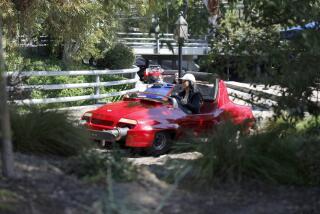Car review: Icon FJ44 custom off-roader has <i>all</i> the bells and whistles
It’s long been said there are only seven basic story lines in all of literature. Increasingly, the same might be said about cars, whose styles are becoming more of a monoculture with each model year. Sedan or subcompact, each genre seems to be defined by a single, rather predictable silhouette.
But not in Van Nuys, where Icon builds low-volume custom automobiles that take classic car shapes and updates them with modern, under-the-hood technologies and stylish in-the-cabin appointments pulled from aircraft, boats and fine watches. In business for five years, Icon builds 20 to 40 vehicles a year with a staff of eight builders.
Icon’s latest, the FJ44, is a four-door, six-seater based on a 1966 Toyota Land Cruiser — marrying a vintage aesthetic with a modern driving experience.
Icon founder Jonathan Ward let me take possession of this $140,000+ utility vehicle he built for a client, allowing me to wheel it over the San Fernando’s Valley’s highways for a day and scramble it into patches of off-road paradise.
Considering its price tag and careful attention to detail, it would be easy to mistake the FJ44 for a poseur — a rich kid who geared up at REI but hadn’t ever gone overnight camping.
Rarely does so rugged a car call out to be touched. But this FJ44, with its powder-coated “volcanic black” matte exterior and multilayered Mercedes canvas top, was handsome and fetchingly tactile. Bespoke craftsmanship is what Icon and the FJ44 are all about. That’s clear from the attention to detail inside and out.
One does not spend six figures, however, for an off-roader that can get to the entry point of the Antelope Valley’s Rowher Flat trails but can’t access the fun to be had in the gravelly ruts of its highest elevations.
To put the FJ44 through its paces I had to first get into the driver’s seat, which was no easy feat. The FJ44 is tall, and there isn’t a doorway handle or a low step to assist. The floor of the cabin is thigh-high to accommodate the 12 inches of clearance under its belly, so it was an inelegant entry that landed me in my climate-controlled Chilewich seat.
A twist of the key brought the fuel-injected General Motors LS 5.3-liter V-8 to life. Getting it in gear came courtesy of a five-speed stickshift protruding from the floor next to twin sticks that switch the FJ44 from two-wheel to four-wheel drive. A trio of aircraft switches on the dash lock the front and rear differentials in place for powering up grades as steep as 55 degrees.
The FJ44 shares the exterior dimensions of the vintage Toyota Land Cruiser it is based on. It is sanctioned with an agreement that Ward brokered with the Japanese manufacturer, Ward said.
The only actual Toyota parts on this Icon are its imported, modern-day hood and pieces of its original frame. Its center of gravity is lower than the original, and its weight distribution is evenly split front and rear for improved handling.
The alloy body of the FJ44 is made by a pontoon boat manufacturer, and the floor is outfitted with drainage holes under marine-grade mats for easy cleaning.
The heavy-duty steering wheel was lifted from a Caterpillar earth mover. The thick metal latches attaching the windshield to its frame were the same as those on a Sub-Zero freezer.
The analog instrument panel and glove box panels were both inspired by Bell & Ross aircraft watches. The dashboard vents were sourced from Cessna, and the double-anodized sun visors were from Leer.
What sounds like a schizophrenic parts catalog is actually a careful sourcing of purposeful, aesthetically appealing details that, surprisingly, coalesce into a complementary, and unique, minimalist design.
The FJ44 has a soft top, and I was driving it on the freeway on a cold and extremely windy day. Having spent part of my youth in a soft-shell MGB that whistled and flapped, I expected the same from the FJ44. It did neither of those things.
The wind didn’t leak in because the soft-top ribs were wrapped with Velcro closures, and the zippers were overlapped with heavy canvas. The zipper pulls were also equipped with “monkey ball” ends that didn’t endlessly shake and rattle.
The cabin was, however, a little loud, which, depending on your viewpoint and the length of time one spends at high speeds, could be chalked up to the FJ44’s character. I attributed it to the gargantuan, 350-horsepower engine, a lack of soundproofing and an intentional decision on Ward’s part to retain a sensory thrill that more directly connects the driver to the driving experience.
The FJ44 has the longest wheelbase of any of the previous three Toyota Land Cruiser customs that Icon builds. While that was a benefit on the highway, it was a mild detractor on twisty roads, where it felt a little unwieldy.
Heading into the upper echelons of the Rowher trails, Ward, who was with me, decompressed the dual-purpose knobbies so we could head into the hills without getting a flat tire or shaking the teeth out of our skulls; a canister of compressed air would reinflate them at day’s end.
Throwing the twin sticks forward to lock the front and rear differentials in place, I headed up a dusty and washed-out grade in low gear, climbing over some fairly severe grades and rocks without heavy breathing.
Not bad for a pretty boy — or a manual transmission, which refused to stall when the going got rough because of an astounding 87:1 gear ratio that allowed the FJ44 to crawl up hills without conking.
Yee-haw. Or, as the moneyed might say, Righty-o.






